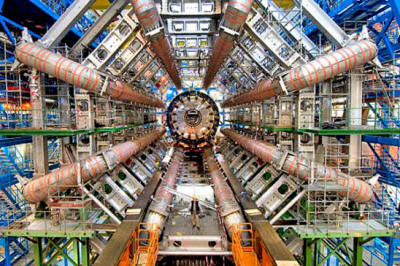|
|
|
by Stephen Smith from Thunderbolts Website
one of four huge detectors at CERN's Large Hadron Collider.
Since the Large Electron Positron
Collider (LEP)
was at the end of its life, and a machine capable of generating more
power was needed, a 20 nation consortium, all members of
CERN (Conseil Europeen pour la
Recherche Nucleaire), started design work in 1994.
Leptons are a group of elementary
particles (and antiparticles), such as electrons, muons, or
neutrinos that are affected by electromagnetic and weak
interactions.
The quark flavors are,
Each of the six quark flavors can have three different colors,
The lepton table includes the,
The
muon and the tau leptons are not
stable, however, and quickly decay.
Quantum mechanics proposes that there are four forces at work in nature:
According to nuclear physicists, a "force" is more like an exchange.
When the strong force binds an atomic
nucleus together, for example, the particles exchange "carrier
particles," called
bosons. Each force requires its own
boson. It is the photon that supposedly carries the electromagnetic
force, and "gluons"
carry the strong force. An ongoing problem for physicists is the
detection of "gravitons" that supposedly carry the gravitational
force.
When particles travel through space,
they encounter this field, acquiring "mass." The concept can be
illustrated by particles moving through a viscous fluid: the greater
interaction of particles with the field, the greater their mass. The
existence of the Higgs field is an essential component of his
hypothesis.
For the last few years, LHC's focus has been to "find" the Higgs boson and determine if this mass origin hypothesis is correct. Recently, physicists announced that LHC had shown hints that the Higgs-Boson was "real."
However, experiments in the 145 billion to 466 billion electron volt range have excluded the boson's existence.
As Dmitri Denisov of Fermilab said:
Electric Universe advocates propose that the entire quantum mechanical universe requires a new viewpoint.
Since it is
the electric force that governs the cosmos,
the behavior, origin, and structure of matter needs to be revised.
One of the most interesting aspects of this premise is the clues
that exist within quantum mechanics, itself.
Looking at the four hypothetical quantum
forces, it can be seen that the strong force is also 39 orders of
magnitude greater than gravity. Perhaps that relationship is better
explained with the electric force.
Physics used to mean investigating the nature and properties of matter and energy. Instead, it has become the handmaiden to mathematics.
|


